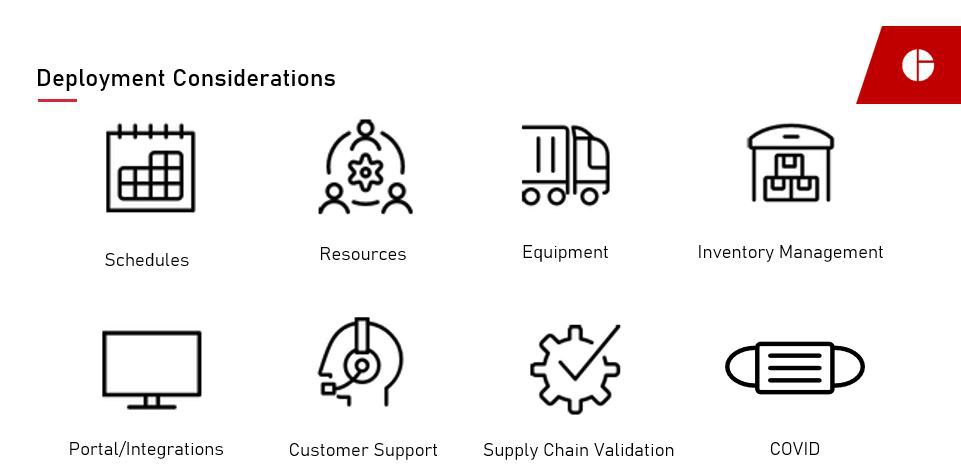Cellular network providers have started to phase out their 2G and 3G networks to make room for newer spectrum like 5G, which means that older technologies using these networks will soon be offline.
If you haven’t upgraded to 4G LTE-enabled devices, your fleet could be at risk for near-term network latency and connectivity issues—essentially losing visibility of your fleet assets. In addition, if you don’t have a plan to upgrade, you could find your entire fleet offline over the coming year as carriers begin to deactivate 2G and 3G networks entirely. Putting together a migration plan now is critical to avoid these problems and unlock benefits.
In our recent webinar, “What the 3G Sunset Means for My Fleet and How to Prepare”, we hosted a panel of experts from Kore Wireless, Milestone, our Chief Product Officer, and Vice President of Account Management to discuss what the 3G Sunset is about, the urgency behind why fleets should upgrade now, key considerations, and real-world experiences and best practices from our customers. Read on for an overview of the webinar and key take-aways

Why You Should Act Now
Global mobile network operators must cater to consumer demand for streaming, gaming, and data consumption. As cellular devices and data-hungry applications proliferate, network capabilities must increase to meet those demands. With a finite spectrum, network operators must decide between investing in new spectrum or repurposing their existing spectrum.
The idea of repurposing spectrum began in 2016 when AT&T eliminated its 2G network, impacting an estimated 10 million active 2G connections. Many other major network operators have followed suit by sunsetting their 2G and even 3G networks—it’s a logical and natural progression as consumers embrace newer 5G technologies with higher speeds.
Some of the current sunset dates include:
- T-Mobile in October 2021
- AT&T in February 2022
- Sprint in December 2022
- Verizon at the end of 2022
The immediate impact on IoT solutions that have been relying on 2G and 3G technology is forced obsolescence of these existing connections. What must be realized is that migration is a when, not if, scenario. Companies need a good future-proof migration strategy that will not put their business at risk. In addition to vague and moving timelines, the actual sunset process is likely already occurring as network operators start repurposing spectrum in some geographic markets, slowing down these networks and impacting connectivity.
What actually happens when sunset occurs? It’s not like switching off a light. It will be progressive and it will begin with a gradual repurposing of the 3G bands. Think of a seven-lane freeway with each lane representing a network operator’s band or frequency. As they re-farm those frequencies over to newer technologies, existing lanes get fewer. Thus the same amount of traffic needs to route over fewer lanes which could cause traffic congestion. It could even affect connectivity. This refarming may start before the actual sunset date as network operators identify geographic areas where little or no 3G network resource is being utilized. The takeaway here is that you don’t have the time you think you have whether you’re a small fleet or large.
How to Choose Upgrades
In a poll conducted, we found that many companies haven’t upgraded from 3G yet because they’re still evaluating technology providers, while others have budget limitations or think the sunset date will get pushed out. While addressing the need to migrate to 4G LTE networks, trucking companies should also take the opportunity to evaluate and select the optimal solutions and partner/provider to get the latest technology and minimize cost/risk.
There are many different factors to keep in mind when upgrading to new telematics solutions. For example, two-way communication, over-the-air firmware upgrades, frequency of reporting, battery life, where you need coverage or if you need roaming capability, communication or environmental certifications, and device accessibility for servicing should be taken into account. Budget constraints, timeframes, and compatibility with existing technologies across your fleet are other challenges to be considered.
There are a few steps to choosing the right device upgrades:
- Identify essential requirements, such as battery life, environment, throughput, security, voice support, and module cost. Different devices have different capabilities for particular use cases, such as simple sensors versus telematic hub devices.
- Assess how upgrades will impact other technologies in place—such as fleet management solutions—and people—including dispatchers, customer support, and other personnel, and plan for those impacts.
- Evaluate new advances now available, such as Bluetooth technology, longer battery life/power management, and video solutions.
In addition to the technical merits, trucking companies should work with companies that can help them with migration and ongoing support. The best telematics companies have a strong reputation within the industry, as well as dedicated support teams to assist with installation and maintenance over time to minimize any disruptions.
Developing a Migration Plan and Deployment Considerations
Don’t let the degradation of 3G networks affect your fleet. Planning is essential to the success of any migration from 3G to 4G LTE or other solutions. While choosing the right technologies is half the battle, successful implementation requires coordination between many different teams, technologies, and resources, which can be daunting to even small fleets with relatively few drivers and vehicles.

The best plans address several concerns:
- Schedules: Customers should know when assets are out of commission for upgrades; maintenance teams need to be at the right place at the right time; dispatchers must understand how to use new technologies; and vendors provide delivery estimates.
- Resources: Upgrades aren’t a one-person project. You have to think about all critical internal and external team members, ranging from vendors to customers. That said, these teams should have a point person responsible for keeping everything on track.
- Equipment: Document all of your equipment and locations. What kind of change outs are needed? Do you need to upgrade gateways or sensors? Match equipment with resources to ensure that someone is responsible for each item.
- Inventory Management: Order devices in a way that ensures inventory is in the right place at the right time. When trucks come in for maintenance, instrumentation should be ready for installation to avoid unnecessary delays and costly downtime.
- Portal Integrations: Many of these devices seed portals that dispatchers, maintenance, and customers use. Ensure that device changeouts don’t affect these integrations in any way. Data should be consistent with minimal downtime.
- Customer Support: Customer-facing teams should be trained and knowledgeable on new technologies. Customers should understand that you plan to address the 3G sunset with minimal disruption.
In addition to these concerns, trucking companies must contend with near-term supply chain disruptions due to COVID-19 and chipmaker issues. Modems, cables, chipsets, and even resins are in short supply. Talk with device providers to understand their lead time and ensure no unexpected delays can throw off even the most well-laid plans.
Partnering with an Expert
The easiest way to ensure a smooth migration from 2G or 3G solutions to the right 4G LTE solutions is to work with an expert partner. Rather than simply selling a device or network access, these partners can help at a deeper level to determine the optimal solutions for your fleet and ensure that those solutions are properly installed and maintained over time.
Powerfleet provides a broad range of 4G LTE-compatible solutions across all asset types, from intermodal equipment to in-cab solutions to trailer and reefer to cargo visibility—a true bumper-to-bumper solution. These solutions are purpose-built from the devices and sensors to software solutions to make sense of the location and conditions of assets. You can easily access asset locations, key performance indicators, and other essential data.
Powerfleet works with some of the most recognizable brands in the world, from Walmart to Knight Transportation. Unlike many competitors, we have an extensive track record of experience, a deep understanding of customer requirements, and we can help you scale from a few assets to large fleets while adhering to best practices. Milestone Equipment has been using Powerfleet solutions for asset visibility and to track utilization. During our 3G sunset webinar, our customer at Milestone shared what his experience has been like working with Powerfleet to upgrade his fleet of chassis.
The Bottom Line
Visibility is obviously critical for all assets. Some assets have more sensitive information needs such as reefers with FSMA requirements and ELDs with hours of service requirements. The risk of waiting to upgrade from 3G may not just jeopardize fleet visibility and operational execution but also regulatory requirements.
The 3G sunset is quickly approaching, and trucking companies should begin the migration process as soon as possible. By selecting the right technologies and developing a migration plan, you can ensure that upgrades are within budget and minimize the risk of disruptions. Powerfleet can be your trusted partner throughout this process to ensure its success.
Contact us today to schedule a free consultation to start your migration! Also, check out the recording of our webinar to listen to the Q&A at the end for additional insights.


